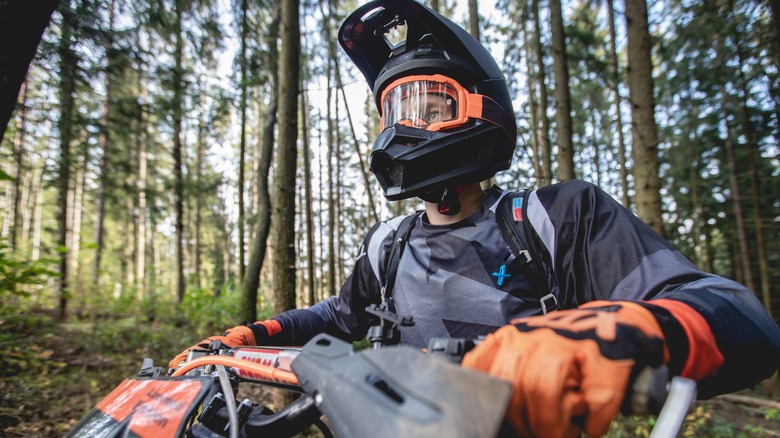
Alexander Shelegov/Getty
Dirt bikes or motocross bikes are one of the most popular types of motorcycles. They’re designed for off-road use and feature things like tires with aggressive tread, extensive fairing to protect the rider and sensitive components, and reinforced suspension systems to handle uneven terrain. While most dirt bikes are built exclusively for off-road driving, some — like dual sport and crossover bikes — are capable of cruising on both pavement and dirt. The two styles are relatively similar, but the street legal versions include equipment like lights, horns, and license plate mounts.
Regardless of whether you own a dirt bike or a dual sport bike, if you plan to do any off-road riding, you’ll need to have a few essential pieces of gear. Dirt bike gear differs from standard motorcycle equipment due to the unique dangers you face when cruising off-road. While pavement is — for the most part — relatively level and smooth, off-road trails tend to be uneven and littered with obstacles like tree roots, rocks, and mud. Furthermore, many dirt bike riders enjoy performing extreme stunts, like jumping and doing wheelies. All of those factors can make riding dirt bikes dangerous, and it’s important that riders take precautions to protect themselves.
Apart from practicing safe riding techniques, one of the best ways to protect yourself on a dirt bike is to use the proper gear. That includes obvious things like helmets and gloves, but it also can mean wearing less well-known items like body armor and neck braces. There are a lot of options for riders to protect themselves, and it’s critical that dirt bike owners, especially new riders, understand how to select the proper safety equipment. So, from helmets to gloves and boots, here are six essential pieces of gear every dirt bike rider needs.
A quality helmet
A helmet is one of the most essential pieces of dirt bike gear that every rider absolutely must have. While using a helmet should be a no-brainer, we’ve all seen riders tearing down roads and trails without one. Unfortunately, many riders don’t consider helmets to be «cool,» or they think they’re too skilled to use one. But the truth is, even the most experienced riders make mistakes, and no one is immune to accidents and injuries.
For dirt bike riders, a Department of Transportation (DOT)-approved helmet is essential. However, before you rush out to your local bike store to purchase one, there are some things you need to know. Dirt bike helmets aren’t the same as regular street motorcycle helmets. For one, dirt bike helmets typically feature an elongated chin and a visor on top to protect riders from dirt, dust, and debris, or, to use a word popular in the motocross community, roost. It’s important that you look for a helmet with a detachable or breakaway visor, as they can get stuck on low branches and other obstacles while riding. You should also look for a helmet with plenty of ventilation to keep you cool and comfortable on the trails.
Finally, it’s important that you visit a store when shopping for a dirt bike helmet, as opposed to ordering one online. While online shopping is convenient, it’s vital that you try your helmet on before buying it. You’ll need to look for a helmet that is comfortable and snug without being too tight or obscuring your vision.
A pair of gloves
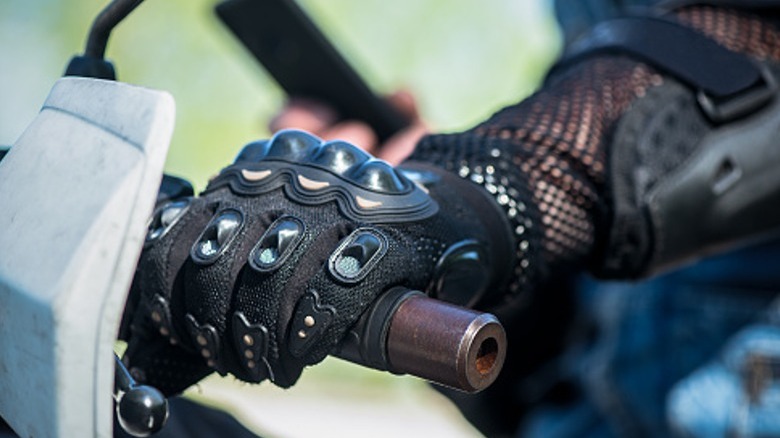
Undefined Undefined/Getty
Our heads aren’t the only parts of our bodies that we need to protect while riding a dirt bike. The unfortunate reality is that essentially every inch of our bodies is exposed to danger while riding any type of motorcycle, but especially dirt bikes, due to the unique dangers that off-road riding presents.
One area of our bodies that we may not always think to protect is our hands. Riding a regular motorcycle exposes our hands to debris kicked up by other motorists. Riding a dirt bike is even more perilous for our hands, due simply to the fact that there are a lot more hazards off-road than there are on smooth pavement. Between clumps of dirt, rocks, and tree limbs, there are a lot of things that can hurt your hands, especially if someone is riding ahead of you. Furthermore, gripping those handlebars during an all-day ride can result in some pretty uncomfortable blisters.
While some dirt bikes are built with special guards to protect riders’ hands, not all bikes have that protection, and even those that do may not shield our hands completely. The best move is to purchase and wear a quality pair of riding gloves. Dirt bike gloves are usually constructed with padding over the knuckles to protect you from debris, while the palm-side may have a textured grip to help you grasp the handlebars without developing blisters. Most gloves feature air vents to allow your hands to breathe and close using Velcro. It’s important that you try your gloves on before buying them, and it’s wise to go with a slightly smaller size than you may think necessary. They’ll most likely stretch with use, and it’s better for them to be a little tight than to be too loose.
Some riding boots
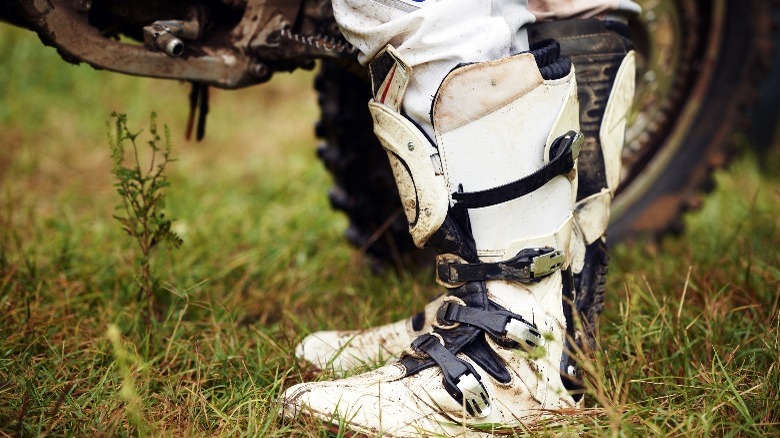
Claudio.arnese/Getty
Your lower legs and your feet are some of the most exposed and vulnerable parts of your body when riding a dirt bike off-road. Riding any motorcycle exposes your lower extremities to substantial risks, including things like burns, crushed limbs, and foot peg injuries in the event of a fall, as well as road debris and other motorists. Riding a dirt bike off-road subjects you to most of those risks and includes a few additional perils of its own. Off-road, you’ll have to deal with new hazards, like uneven, inconsistent terrain, rocks, and plant life. Even well-traveled trails have twists and curves, boulders, and gnarled tree roots. You don’t need to fall to injure yourself off-road, as it’s easy to swipe tree limbs and other obstacles. None of that takes into account the extreme stunts many riders enjoy. Jumping and performing other tricks can put extreme stress on your feet and ankles, especially if done incorrectly.
Dirt bike boots offer a practical way to protect your lower legs, ankles, and feet. They’re extremely stiff to prevent sprains and provide protection against injuries from your bike’s engine and foot pegs, as well as external obstacles, like tree limbs and rocks. Many boots are built with impact-resistant and shock-absorbent materials to protect riders from various hazards, including jumps and stunts, as well as a hinge at the ankle, allowing riders to utilize their shift and brake pedals without hyperextending their joints. While trying on boots before buying them is always ideal, you can buy dirt bike boots online if you know your size, as you should buy them in the same size as your everyday shoes.
Goggles to protect your eyes
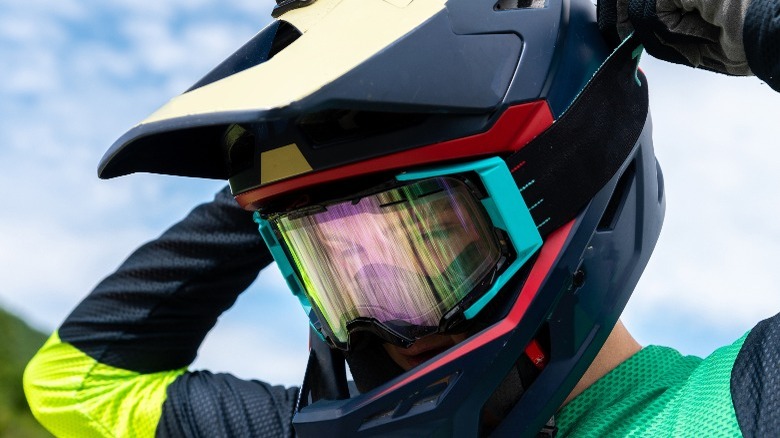
yanik88/Shutterstock
Your eyes are one of your most important and exposed sensory organs. Unfortunately, riding a dirt bike exposes your eyes to substantial hazards, like dust, flying debris, and tree branches. You’ll also have to deal with things like wind, the sun, rain, and mud.
Fortunately, dirt bike goggles are neither overly expensive nor uncomfortable. They come in various different styles, but most are built with durable, shatterproof Lexan glass or injected-molded Plutonite lenses. They may be tinted for protection against the sun’s glare and UV rays, and have various colors. Many dirt bike goggles allow you to install tear-off or roll-off systems to quickly remove dirt and debris, and some are even bulletproof.
One thing to keep in mind is that it’s wise to purchase your dirt bike helmet before your goggles. That way, you can try on goggles to see how they fit with your helmet and ensure that they’ll be comfortable and provide you with a solid field of vision. A wider strap may help you keep the goggles more stable on your helmet, while outriggers, the plastic pieces where the straps connect, allow you to position your goggles inside the helmet for a more comfortable and secure fit.
A neck brace
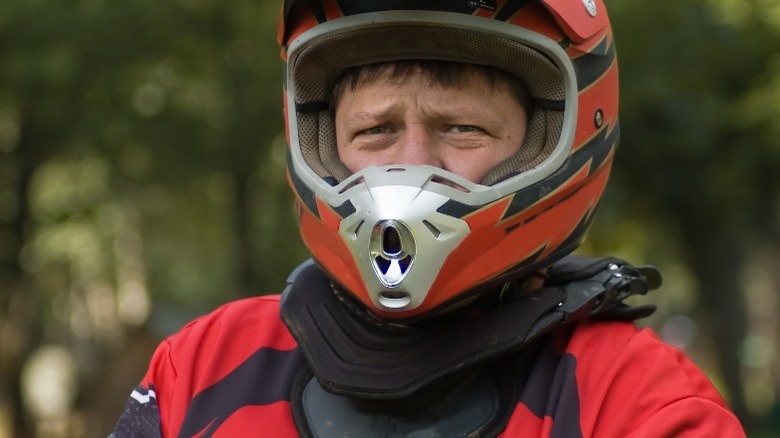
Gina Callaway/Shutterstock
When getting into the world of dirt biking, a lot of people stop with the gear we’ve already described. That may be okay for some riders, like those who plan to stick to light, well-maintained trails or those who use their bikes for things like farm chores. However, anyone who plans to do any extreme off-road riding, compete in motocross events, or test their skills with jumps and other stunts needs to invest in a few other items.
One of the most essential pieces of dirt bike gear for riders who plan to do anything more extreme than casual riding on relatively even terrain is a neck brace. These devices are designed to protect your neck and spinal cord by preventing overextension to the front, back, and sides and preventing spinal cord compression. They slide over the rider’s head and sit on top of the shoulders. They should not be too tight or prevent you from moving. Ideally, you should be able to fit your fingers between your back and the brace. If it feels too snug or moves around too much, the fit isn’t correct. While many riders dislike neck braces and consider them to be uncomfortable, they’re vital pieces of dirt bike gear, and they can prevent serious injury in the event of a crash.
Some body armor
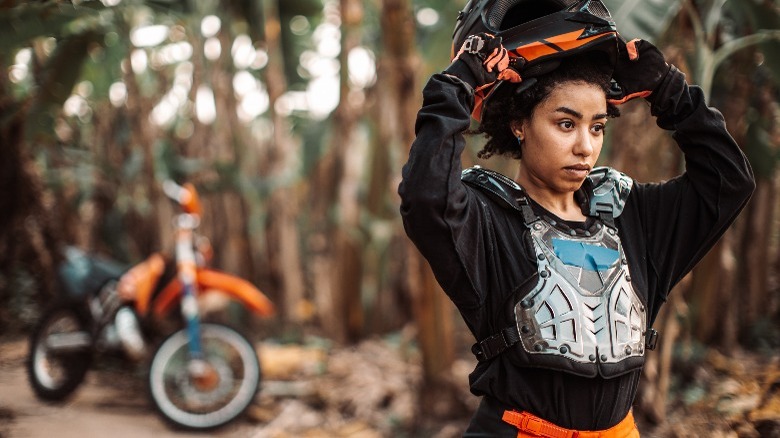
Redrooster2/Getty
The final pieces of essential dirt bike gear you should consider are body armor. We’ve already mentioned many of the hazards that you face when riding a dirt bike off-road, and we’ve covered several ways to protect various parts of your body. However, using only the gear covered above leaves a lot of your body exposed. And if you’re competing in motocross events, performing dangerous stunts like jumps, or riding on perilous and uneven trails, it’s worth picking up a few additional pieces of gear to protect some of the most vulnerable parts of your body.
Roost guards and chest protectors are both designed to protect your torso. Roost guards are ideal for motocross racers and are built to protect riders from dirt and debris kicked up by other competitors. Chest guards are heavier duty and designed to protect riders from things like tree branches, rocks, and hard impacts in the event of a fall. There are also things like knee braces and guards to protect your legs and knee joints from collisions and debris. Like the other items covered here, it’s important to try these products on before making a purchase. They should fit snugly, but not too tight. And if your body armor hinders your movement, you should look for a different style or fit.